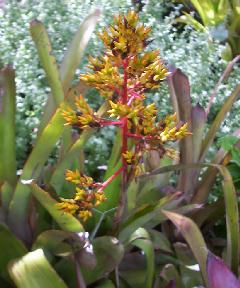
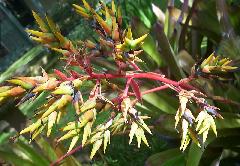
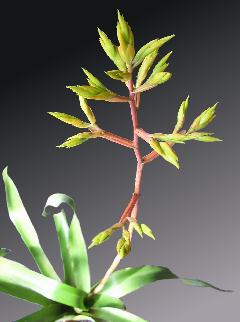
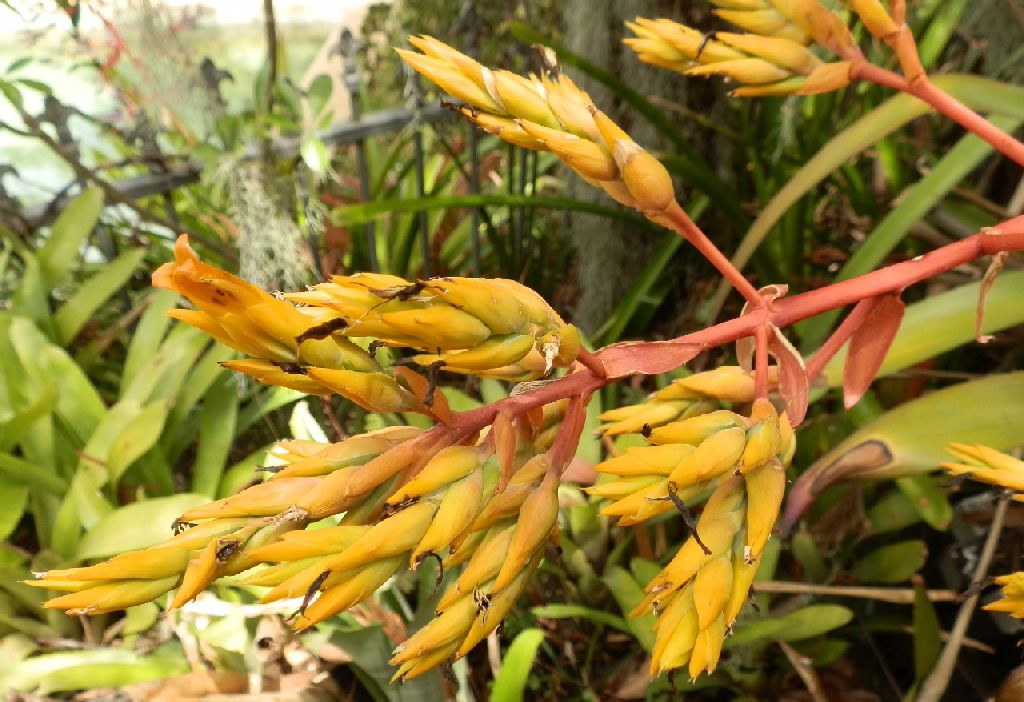
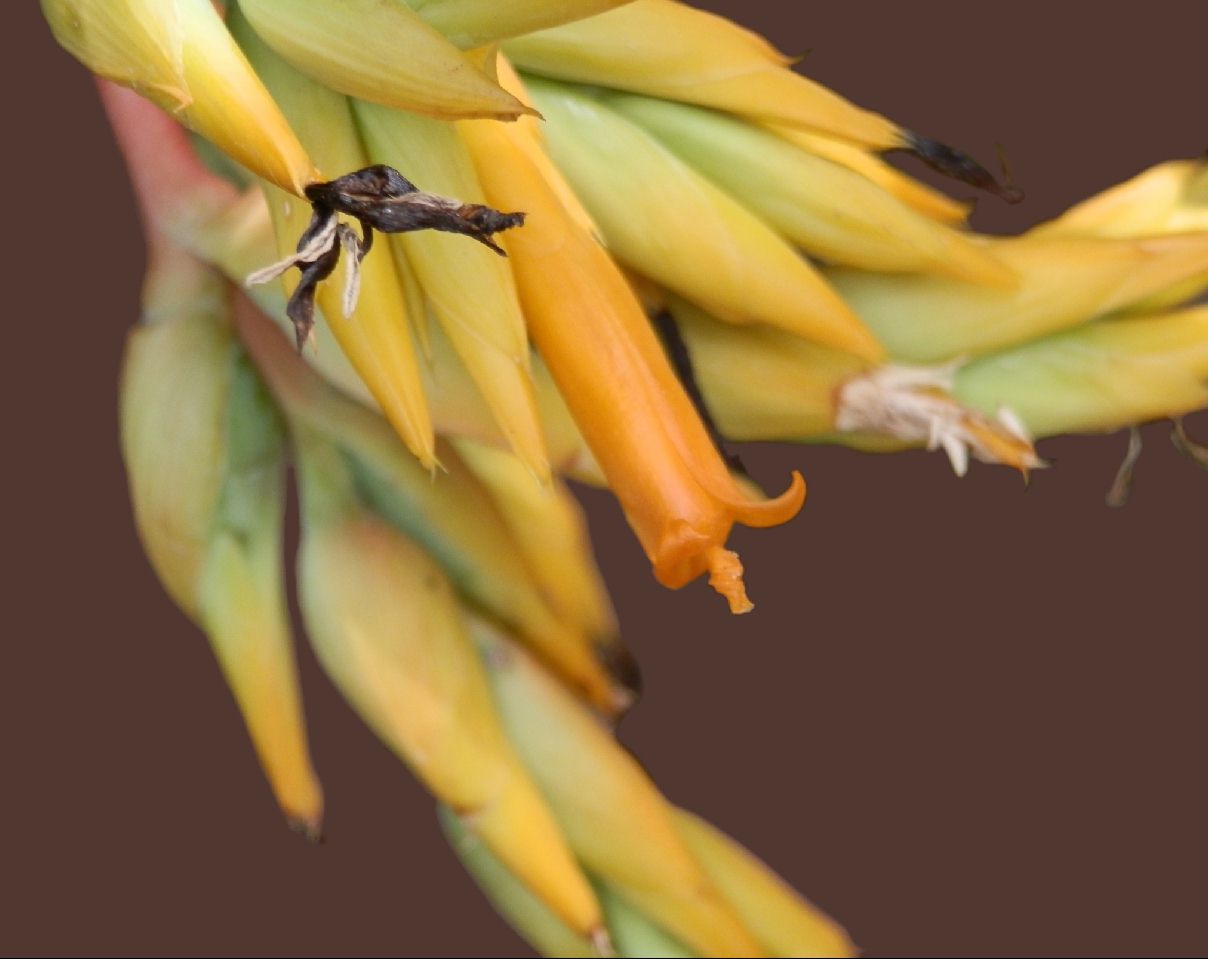
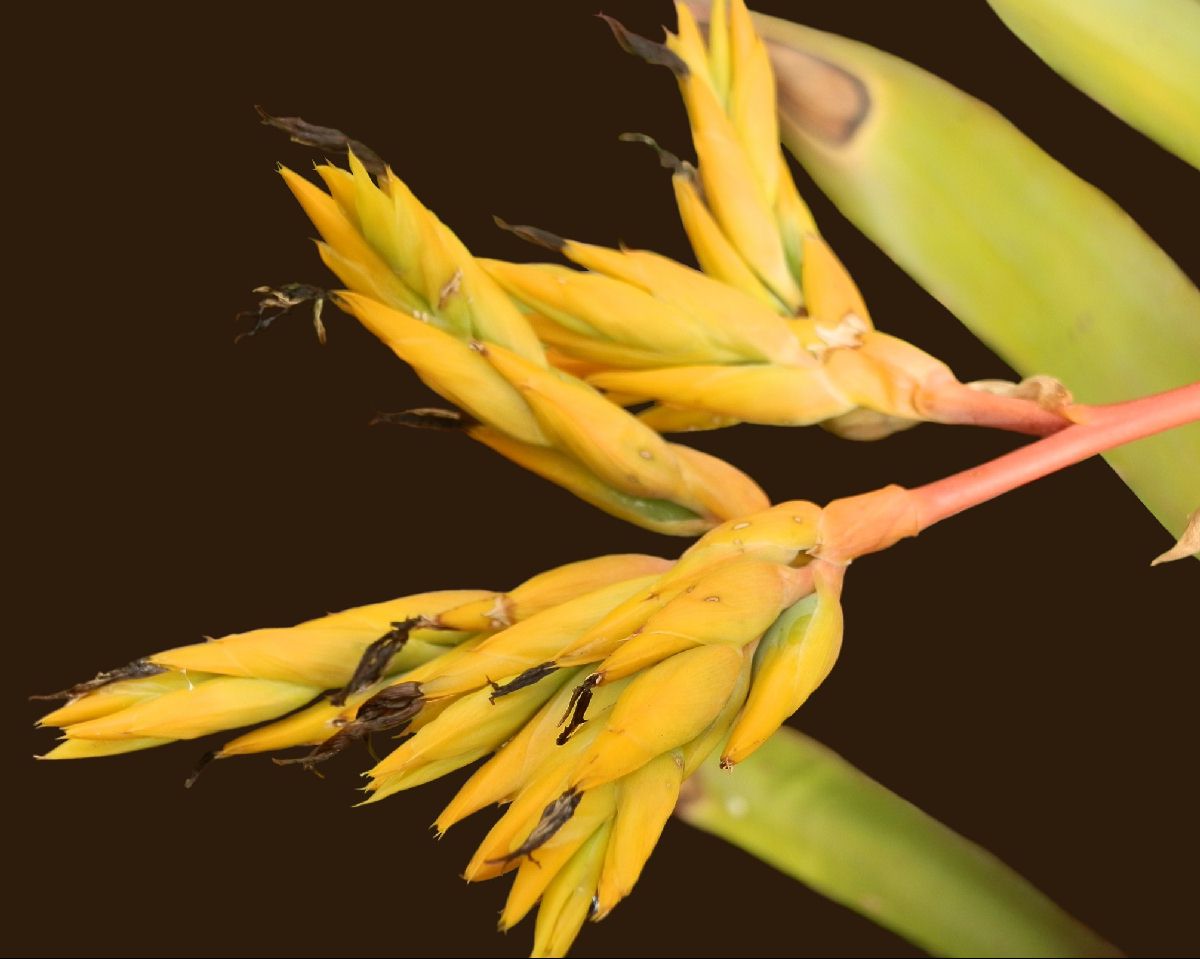
AECHMEA callichroma by Peter Franklin in Bromeletter 32(3): 8-9. 1994
There have been a number of articles over the last 12 months or so concerning this newly named species and its relationship with the other taxa in the Gravisia complex. I don't want to go over the ground that has already been covered in the BSI Journal and Selbyana but it is now time for all of us to take notice of these articles and look critically at the so-called Aechmea mulfordii, rubens, eurycorymbus, aquilega et al in our collections. Just because Ae. callichroma is a newly described species, it doesn't mean that it doesn't already exist in collections. Remember that Ae. callichroma is described from cultivation and may have been in cultivation for a very long time under some other name. This would appear to be the case with Ae. callichroma - at least in my collection.
With the new material in the BSI Journal and Selbyana I have keyed out the plants in my collection that fit into this general area of Aechmea, when they have come into flower.
The results for my plants are as follows:
This is not the sp.'Ecuador' plant now identified as Ae. penduliflora | |
When grown in the open, Aechmea callichroma goes a dark red - almost black, and under protection grows larger and greener but, of course, the inflorescence is identical. I have also noticed that the Aechmea callichroma plants are in the most part self-fertile which may account for the appearance of so-called Ae. eurycorymbus and Ae. mulfordii seeds in the seed Bank.
One by-product of this exercise has been that, unfortunately, I no longer have any Ae. mulfordii - all the plants that I thought were mulfordii are in fact something else!
It is impossible to make judgement on anyone's plants without seeing them in full flower so I am certainly not suggesting that you immediately go out and change all your name tags. That would lead to chaos of the highest order. But next time one of these plants comes into flower, check it against these most recent descriptions, check it against the drawings, and take it into your local society's meeting for discussion. If you are in any doubt, ask for help in identifying the plant. In the case of Ae. callichroma and its allies, because the descriptions are newly researched and the drawings very accurate, keying out the plant is not too difficult.
Of course the best idea, (if you can afford the Australian postage on such large items!) is to send as much as you can of a flowering plant and the small fee to Harry Luther and get a professional identification.
Aechmea callichroma R. W. Read & U. B. Baensch, sp. nov. Selbyana 12: 60-2 1991
Aechmeae mulfordii affinis, sed floribus in spiculis distinctis axes elongatos possidentibus et bracteis floralibus marginibus hyalinis distinctis provisis distinguenda.
Type. Cultivated: R. W. Read #90-20 (SEL, holotype; US, HB, RB, isotypes). THE BAHAMAS: Nassau, Tropic Beauty, by Ulrich Baensch, flowered July 1990,
Plant flowering over 1m tall;
Leaves ca. 14, ca. 1m long, spreading basally but at maturity closing the reservoir forming a bottlelike rosette;
Sheath distinct, entire, broader than the blade, ca. 10cm wide by 15-20cm long, densely brown-lepidote adaxially, purplish but gray-lepidote abaxially;
Blades strap-shaped, arcuate, channeled, ca. 1 m long, 5-6.5cm wide, subdensely serrate with dark sharp teeth, yellow-green to purplish and obscurely lepidote adaxially, gray-lepidote abaxially, apex rounded and strongly mucronate with a dark spine 5-10 mm long;
Scape stout, ca. 50cm long, 15mm diam., soon glabrous, bright red at anthesis, lasting until fruiting;
Scape-bracts red at first, clasping, imbricate, ca. 13cm long, elliptic, entire, not entirely obscuring the scape, tan and papyraceus when dry , lightly pale lepidote, especially abaxially; inflorescence tripinnate, ca. 50cm long, laxly branched; axes soon glabrous;
Primary bracts red, like the scape bracts, much longer than broad, nearly equaling to shorter than the sterile portion of the lowermost branches; branches elongate, spreading-ascending, 10-25cm long, the lowest with the spike lets somewhat separated;
Spikelets polystichously, densely flowered along an elongate axis, 7-12cm long;
Floral bracts bright yellow, ovate, mucronate with a 2mm long mucro, clasping the rachis below the flower, 17-20mm long, 12-14mm wide, exceeding the ovary, not equaling the sepals, subchartaceous, strongly nerved, broadly convex, carinate for most of their length, glabrous;
Sepals yellow, 14-16mm long, plus I mm long mucro, asymmetric with a large semi-elliptic wing, connate 2mm, 2 posterior sepals carinate and decurrent onto ovary , anterior sepal ecarinate, glabrous;
Petals yellow, ca. 25mm long, with 2 irregularly dentate margined infundibuliform appendages at the base, and 2 parallel fleshy ridges or folds clasping the adnate portion of the stamen-filament;
Stamens included, ca. 21mm long, filaments alternately adnate to the petals ca. 15mm, anthers ca. 9mm long, dorsa-fixed near the middle, pollen grains globose; ovary bicarinate, at first green becoming yellow then purplish-black at maturity, glabrous, 6mm long; epigynous tube ca. 2mm high; placentae full length of central axis; ovules caudate.
Distribution. Probably Eastern coastal Brazil, but known only from cultivation.
Etymology. Named "beautifully coloured" in reference to the entire plant with its green or purplish leaves suffused with silver-gray scales and the inflorescence of bright red axes, and yellow floral bracts and sepals.
Cultivation. This species has been in cultivation for some time, but because of the considerable taxonomic confusion within this group, it has remained unrecognized as distinct. It has often been confused with Aechmea mulfordii as a result of a slightly distorted published illustration. The illustration of A. mulfordii published in the monograph by Smith and Downs (1979) exaggerates the elongation of the rachis, and does not illustrate the fact that the spikes are strongly digitately congested into fascicles of very much foreshortened spikes. Furthermore, in A. mulfordii the primary bracts equal or are only slightly shorter than the branches, while in the present species, the primary bracts only equal the sterile portion of the lower branches, and the spikelets are not fascicled.
Aechmea callichroma, A New Species described from Cultivation by Robert W. Read and H. Ulrich Baensch (1) in J Brom Soc 44(1): 17-19. 1994
During preliminary preparation for a book on bromeliads and the requisite verification of identifications, a mysterious and colourful group of plants growing at Tropic Beauty (2) demanded our attention: Aechmea aquilega, A. rubens, A. lanjouwii, and A. mulfordii. All four, included in the now-defunct genus Gravisia, are robust plants ideally suited as landscape subjects in the coastal regions of the tropics and subtropics. With rosettes up to a meter high, and forming large clumps, they produce long-lasting, colourful inflorescences from one to two meters tall. Among the numerous plants of this group at Tropic Beauty, two distinct species had been identified with A. mulfordii at one time or another depending on who the identifier was. This confusion no doubt resulted from the publication of a misleading illustration in the Smith and Downs monograph.(3) It was obvious, however, that the plants in hand did not agree with the L.B. Smith description.
Harry Luther recognized the problem when he attempted to identify material sent to the M.B. Foster Bromeliad Identification Center at Selby Botanical Gardens. He tried to make it easier to identify the different plants by preparing an illustrated key (4) to the species. The distinctions remained unclear, unfortunately, because of the distorted illustration of A. mulfordii in the monograph. Furthermore, it was not understood that, as the inflorescence of Aechmea rubens developed, the spikelets came to resemble the A. mulfordii illustration, contributing further to the confusion. Read and Luther corrected this problem in a paper published in Selbyana (5).
After considerable study and comparison of living material, one taxon stood out conspicuously as distinct and recognizable, with no clear relationship to any known species. That plant, Aechmea callichroma Read & Baensch (6), is probably not of recent hybrid origin because there are no obvious clues to parentage in the complex, and plants of this species have been in cultivation for a considerable length of time. A. callichroma is most likely from eastern Brazil but more recently by way of Bob Wilson's Fantastic Gardens in Florida through Stanley Smith (7) to Tropic Beauty.
The name "callichroma," meaning lovely colour, alludes to the outstanding and long-lasting colours typical of this species. Aechmea callichroma tends to be more like A. aquilega in the size and ampulate, or slightly bottle-form, shape of the rosette resulting from the slightly inflated leaf bases and lower portion of the leaf blade. In similar manner, the leaves normally exhibit a silvery gray coating of mealy scales barely masking the purplish maroon of the leaf surface. The floral bracts, sepals, and petals are bright orange-yellow, contrasting sharply with the red axes and green ovaries. Mature fruits are purplish black.
Aechmea callichroma can be distinguished easily from A. mulfordii by its flowers, which are arranged along a distinct axis, not in tight fascicles or crowded spikelets, and by the large, lowermost primary bract, which nearly equals or is shorter than the stalk supporting the lowermost branch. Also, the floral bracts of A. callichroma are barely longer than the ovary which is fairly exposed, while those of A. mulfordii are broadly ovate and more tightly congested, thereby mostly concealing the ovary. From A. rubens, this species differs in the much shorter and yellow (not orange or red) floral bracts.
This species is an excellent candidate for landscaping in moderately frost-free areas when used in full sunlight or light shade. The brighter the light the better the form and colour. Close relatives are known to thrive on rocks or as terrestrials, frequently with mangroves under saline conditions. Flowering is generally in late spring and remains colourful for a considerable time.
End Notes:
(1). Dr. Read's address is: 272 Rose Apple Lane, Naples, FL 33961; Dr. Baensch's address is P.O. Box N I105, Nassau, Bahamas.
(2). Tropic Beauty is the Nassau home of Dr. and Mrs. Ulrich Baensch and the repository of their extensive collection of bromeliads.
(3). L.B. Smith & R.J. Downs, Bromelioideae (Flora Neotropiea monograph no. 14, pt. 3); 1979: 1824, fig. 615 i and j.
(4). H.E. Luther, Some confused aechmeas (Misnamed bromeliads, No. 6). J. Brom. Soc. 40(4): 154-156; 1990.
(5). Selbyana 12:54-67;1991. Copies may be obtained by sending $2.00 to the author at Quest End, 272 Rose Apple Lane, Naples, FL 33961.
(6). The description of this new species appears on pages 60-62 of Selbyana, 12; 1991 (see note 5, above).
(7). Stanley Smith accumulated a large collection of tropical plants in Nassau during the 1950s, many of which came from growers including Robert G. Wilson, founder of Las Cruces Botanical Garden in Costa Rica. He originated and introduced the Lasagne Fern (Asplenium nidus var. plicatum). The Stanley Smith Horticultural Trust was established upon his death. In 1979, his widow sold the bromeliad collection from which Ulrich Baensch acquired a representative of each species.